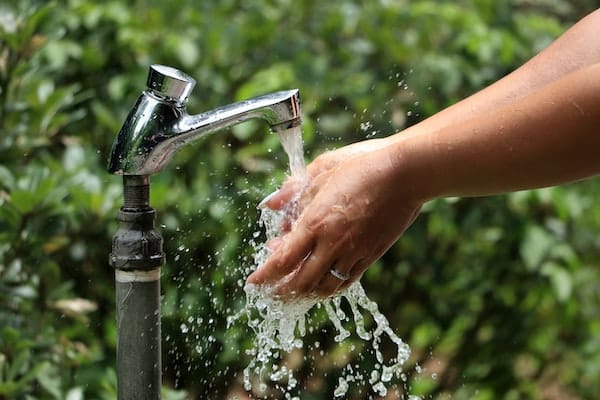
- Test your water quality when noting a change in smell, color or taste
- Regularly test private water supplies like wells for pollutants, viruses and bacteria (not regulated by local authorities)
- Install and maintain water softeners in your home to reduce higher mineral levels of calcium & magnesium
- Install a reverse osmosis drinking water system to eliminate contaminants
- Use sediment filters to reduce dirt, sand, dust, debris and cloudiness
- Install a whole house carbon filter to eliminate chlorine, lead & other dissolved metals
- Run cold water for at least two minutes before first use each day to reduce copper or lead
- Use only filtered water for mixing baby formula – boiling water does not remove lead
- For drinking & cooking, use only the cold tap, then heat water to reduce lead
Good water quality is essential to your health, the wellbeing of your family and even your pets. Knowing signs of poor water quality and what to do if you encounter them can ensure that the tap water you consume on a daily basis is safe and tastes good at the same time. Good water quality can also extend the life and efficiency of your appliances.
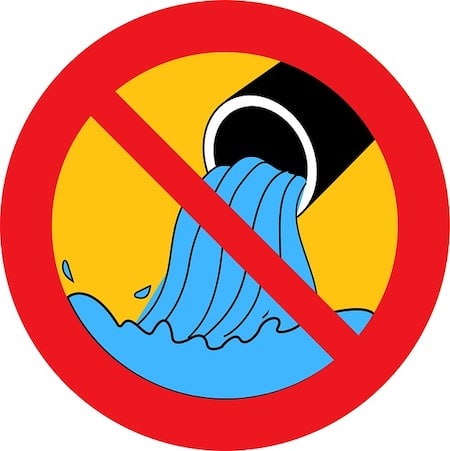
Jump To Contents
- Why Water Quality Matters
- Comparing Water Quality Around the USA
- Review Water Quality Report for Your Area
- What Is Tap Water?
- What’s In Tap Water?
- Is Tap Water Safe to Drink?
- How to Improve Water Quality Checklist
- Signs of Poor Water Quality
- How to Test Water Quality
- Protect Our Waterways With These Safety Tips
- FAQs About Nashville Water Quality
Why is Water Quality an Important Issue?
The Flint Michigan Water Crisis that began in 2014 speaks to the risks posed by poor water quality. The water crisis started when, under financial distress in 2013, the city switched their water source from Detroit to the Flint River, despite the raw sewage and industrial waste that contaminated the river.
City officials neglected to treat the polluted water properly so that when it reached the taps of Flint residents, it contained lead from old pipes, excessive chlorine and infection inducing bacteria that, when exposed, resulted in 90 people becoming sickened and 12 deaths.
The Flint water crisis is just one of many public health crises caused by poor water quality. Erin Brockovich was successful in bringing litigation against Pacific Gas & Electric Company in 1993 for having contaminated the water supply of the California town of Hinkley with toxic chromium-6. Even decades after winning the settlement, she continues to hold other corporations like this accountable for polluting people’s water.
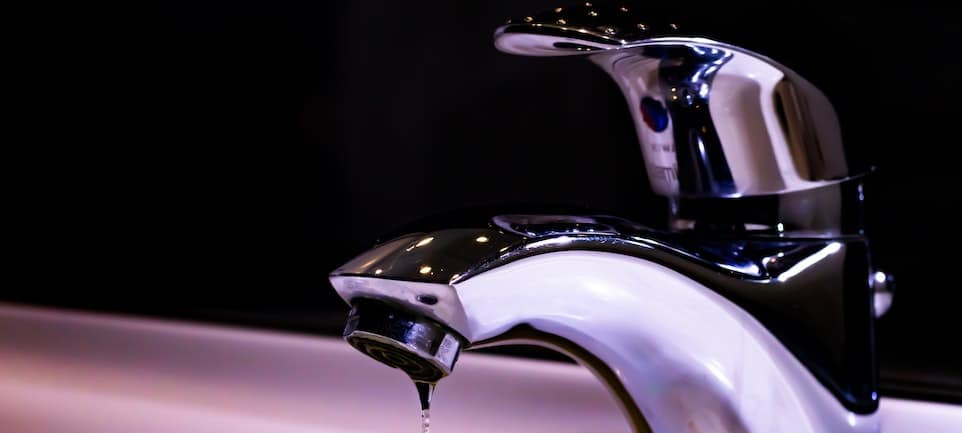
Comparing Water Quality Around the USA
The US Environmental Protection Agency (EPA) rolls out water quality data for the United States according to criteria from the Clean Water Act. They focus on approximately 150 pollutants and provide guidance on three main areas1:
- Aquatic Life
- Human Health
- Taste and Odor (aka “Organoleptic Effects”)
One way to determine the best and worst water in the US comes through observing the weighted point system used by the EPA to track when and where violations of a law occur, accounting for both treatment practices and level of contaminants. The 2019 survey below takes note of violations per state to determine the winners and losers for water quality throughout the 50 US States.
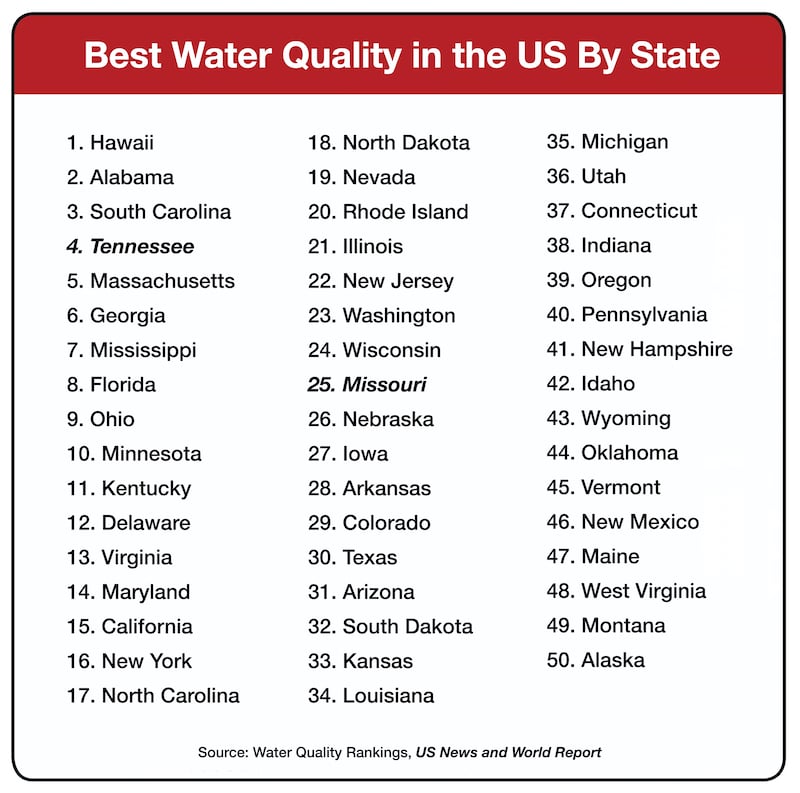
Spotlight On Tennessee Water
As noted by the US News and World report Study above, Tennessee ranks number four in the USA for the Best Water Quality. The inclination to celebrate should of course be balanced against regional reports since local incidents do still occur.
The Tennessee Department of Environment and Conservation (TDEC) has estimated that about 30 percent of the state’s streams are of such poor water quality that they cannot support a healthy population of fish and other aquatic wildlife, and almost 40 percent are not fit for human recreation.” – University of Tennessee Institute of Agriculture
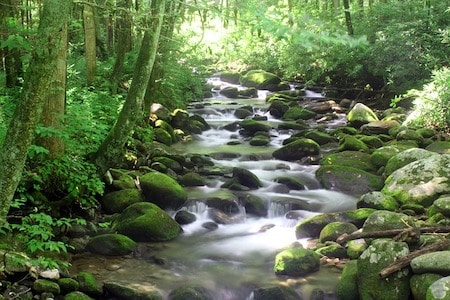
A Closer Look at Nashville Water
The Environmental Working Group (EWG) performed a drinking water quality report for the quarter January 2019 – March 2019 for utilities serving Nashville, TN. Contaminants were discovered in water provided by each utility, with the highest amount of total contaminants being measured at 14, with eight of those exceeding EWG health guidelines.
One contaminant in particular that has been found in the city’s water in prevalent amounts is Disinfection Byproducts (DBPs). These come about when chlorine, which is often added to water by municipalities as a disinfectant, reacts with organic materials in the water to form DBPs. Many types of DBPs are known to increase the risk of many types of cancers.
Review Your Local Annual Drinking Water Quality Report
If you’ve never taken the time to review the water quality in your area, a local annual report may already be in your inbox. Each year by July 1st, your local water supplier is required to deliver an annual drinking water quality review, known as the Consumer Confidence Report (CCR). This report details the public source of the water connected with your property and what that water contains in it.
What is Tap Water?
Water supplied to your home’s tap through your local water utility or an individual water system, which acquires water from either a surface or groundwater source, is considered tap water. The water you’re receiving from the tap has generally been sent from the source to a treatment facility to be processed and sanitized in order to meet certain drinking water standards set by the EPA, unless you receive water from an individual system like a private well. Individual water systems don’t have to uphold these same requirements set by the EPA and should be tested regularly.
What’s In Tap Water?
These public health crises have brought the quality of our tap water across the nation under scrutiny. Although the EPA regulates 90 contaminants in our water, it is estimated that the United States uses more than 60,000 chemicals in drinking water. Although some of these have been found to be harmless when consumed in small concentrations, others like arsenic have been associated with cancer.
According to the Centers for Disease Control and Prevention (CDC), the leading contributors to unsafe water quality include:
- Land use or agricultural practices like fertilizers, pesticides, or animal feeding
- Chemicals and minerals including uranium, radon and arsenic
- Sewer overflows
- Manufacturing waste
- Wastewater treatment malfunctioning
Is Tap Water Safe to Drink?
Public suppliers of water are required to maintain certain levels of water quality that are set by the EPA. This federal government agency holds responsibility for regulating contaminants in drinking water that have been known to pose health risks. The Safe Drinking Water Act passed in 1974 gave the EPA this authority to set drinking water standards and oversee water suppliers. It also allows individual states to enforce their own water standards, if these standards are at a minimum as stringent as EPA’s national standards.
The Safe Drinking Water Act was updated in 2017 to better support public water systems and encourage compliance by water systems under certain drinking water regulations. The highlights of this update include:
- Expanding regulations for previously unregulated toxins
- Reducing lead in school drinking water systems
- Ensuring that communities and states are informed of a release of contaminants into water sources
- Improving the collection of compliance monitoring data
Under The Safe Drinking Water Act, public water systems are mandated to notify citizens if water is ever found not meeting EPA or state standards. For example, the freezing temperatures that hit Houston and surrounding parts of Texas in early 2021 resulted in the issuance of a boil water order for millions of people. Residents of these areas were instructed to bring water to a rolling boil for two minutes before using it, as water treatment centers around the area experienced power outages and burst pipes that had a direct impact on water quality.
The takeaway: Always stay vigilant and follow through with any water concerns issued in your community.
Essentials for Improving Your Water Quality
What should you be doing to create and monitor healthier water for drinking and use at home? Review our checklist below and click the image to download.
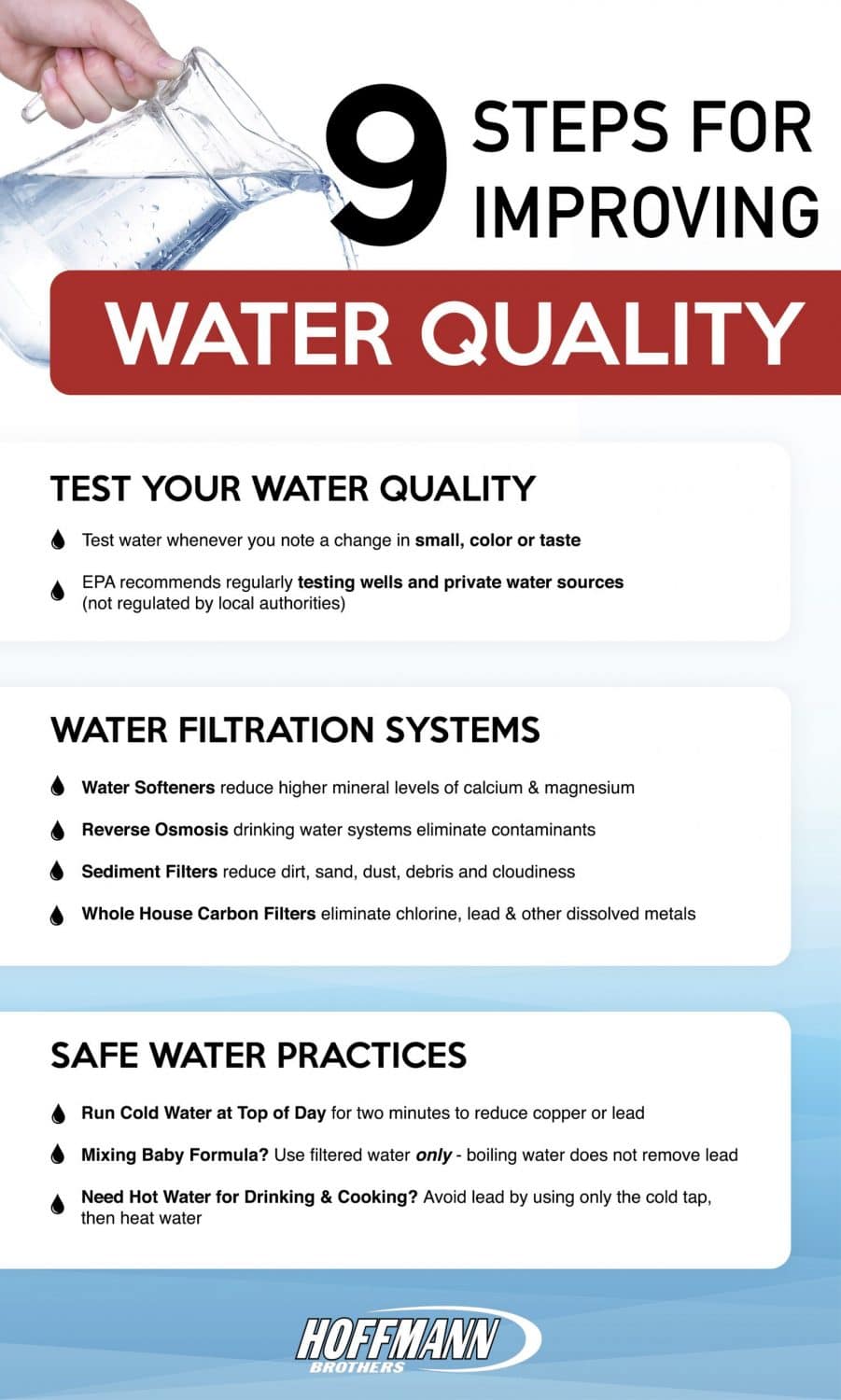
One item on the list that is not always understood are the differences between the separate sources on many faucets for using cold and hot water. With an important focus on levels of lead in drinking water, the EPA notes:
USE ONLY COLD WATER FOR COOKING AND DRINKING. Do not cook with, or drink water from the hot water tap. Hot water can dissolve more lead more quickly than cold water. If you need hot water, draw water from the cold tap and then heat it.”2
Signs of Poor Water Quality
Excess chlorine in tap water is not the only issue homeowners should pay attention to. Some other troubling signs to look out for with tap water include the following:
Water Tastes Like Metal & Other Strange Tastes
Sediment build-up in pipes may cause your water to taste metallic. If only your hot water tastes metallic, this could be a sign that your water heater has sediment build-up. Flushing out your water heater periodically can help prevent this sediment build-up from streaming into drinking water. A strange taste could also mean that there’s excess iron or copper being released from pipes into your drinking supply.
Water Smells Like Rotten Eggs & Water Odors
As tap water shouldn’t have a particular scent, this could be a troublesome sign. A sulfur smell in water, or when water smells like rotten eggs, it could be caused by hydrogen sulfide. This is a naturally occurring compound in groundwater that, when exposed to certain bacteria, turns to sulfate that can cause adverse health effects.
If your water smells like sewage, it could mean your drain is backed up, while a bleach odor could be caused by excess chlorine. When your water smells like fish, it could mean that your water contains barium or cadmium, both produced in industrial processes.
Cloudy Tap Water
Cloudy water could result from air bubbles, which eventually dissipate after a few minutes. However, if the cloudiness stays, this could be a sign something is wrong. One explanation for cloudy tap water is that there is sand or dirt in your pipes. Another explanation is that you have hard water. Hard water is an undesirable condition in which the tap water is full of minerals like calcium and magnesium.
These minerals not only cause cloudy water but can also become deposited and even clog household appliances, pipelines and water heaters, which can lead to major plumbing issues in the future. It’s wise to consider installing a water softener in your home as these work to soften water by removing these minerals that cause hard water.
How to Test Water Quality
If your tap water is being supplied by a public water system, these typically test water quality as a regular part of water monitoring. However, you are responsible for assuring that tap water that doesn’t come from a public water system, such as that of a household well, is safe. In this situation, it’s recommended that you perform routine testing for some of the common drinking water contaminants. A water test kit or testing it through a local laboratory are two options. A local professional contractor or plumber that provides water treatment services can also provide testing.
Protect Our Local Waterways: Steps To Improve the Water We Discard
When you flush, hose off or send water down a drain, in many communities that water will make its way to a local treatment center. Since these centers are not designed to treat hazardous chemicals, it’s important to only discard organic materials to avoid contamination of coastal waters, local rivers and lakes.3
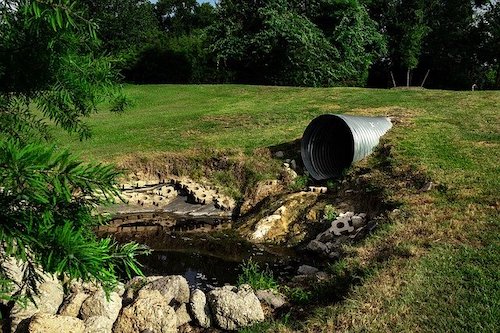
Keep these practices in mind to protect our local waterways:
- Never discard trash or waste in the street or storm drains.
- Dispose of pet waste properly by removing from yard and putting in trash
- Landscape responsibly with safe lawn chemicals and native plants to increase water infiltration
- Conserve rainwater with rain gardens or rain barrels and by ensuring that downspouts on a house drain channel water onto gardens and lawns.
- Avoid washing cars on driveways or in the street to prevent dirt and grime from washing into the nearest sewer drain. Instead, wash it at a professional car wash or in the grass.
FAQ’s About Water Quality
The CDC recommends an annual test for “total coliform bacteria, nitrates, total dissolved solids and pH levels.” This becomes particularly important if you are using a new well, or “have recently replaced or repaired pipes, pumps or the well casing.
Public water systems in the USA are regulated by the U. S. Environmental Protection Agency(EPA). However, private systems like wells are not regulated by government agencies and must self-regulate and test for safety.
While water does have several chemicals and minerals that naturally occurring, it’s important to scrutinize these common sources that may contaminate your drinking water:
- Fertilizers
- Pesticides
- Livestock
- Factories and Manufacturing Centers
- Sewer Line Breaks and Malfunctions
- Wastewater treatment center Malfunction
Good water quality promotes overall health, saves the environment as it reduces water bottle consumption, and can help your appliances run at top efficiency. With professional water testing being the best way to investigate the state of your tap water, there are several additional steps you can take if you’re wondering how to improve water quality, from installing filtration systems to taking other proactive steps in your community. This will help you achieve high water quality in your Nashville home and safeguard your family from any harmful contaminants.
Need help with improving water quality? Visit our Nashville Water Treatment page to get started today.
Footnotes:
1. [https://www.epa.gov/wqc/national-recommended-water-quality-criteria-tables]↩
2. [https://www.epa.gov/sites/production/files/2015-09/documents/2002_5_17_lcrmr_guidance_lcmr_lead_public_education_poster_v1.pdf]↩
3. [https://www3.epa.gov/npdes/pubs/centralized_brochure.pdf]↩


